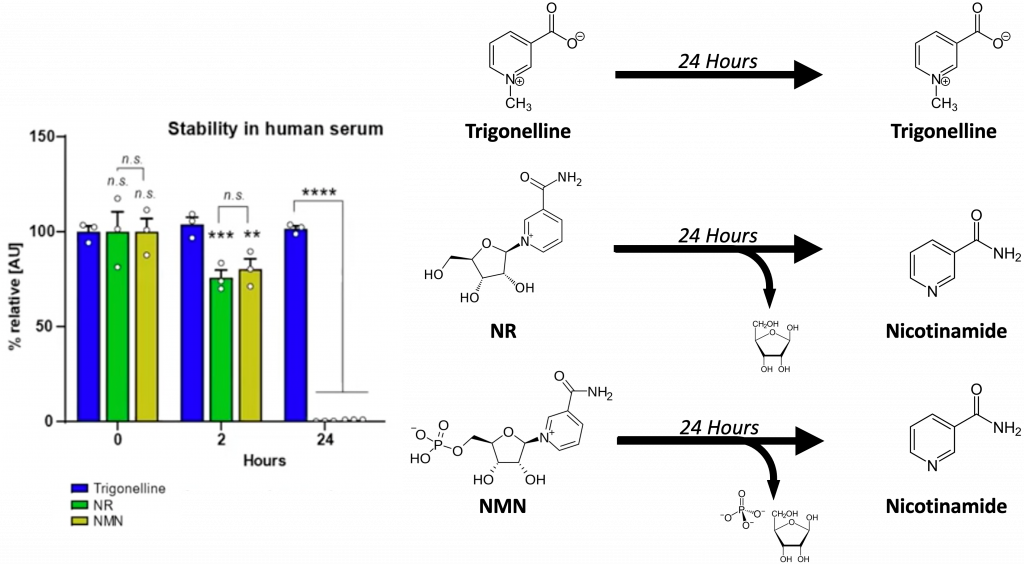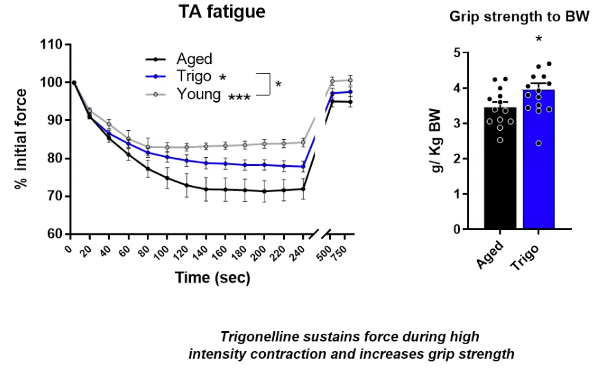Key Points:
- Trigonelline is more stable than the most famous NAD+ precursors NR (nicotinamide riboside) and NMN (nicotinamide mononucleotide), but the implications of this are unclear.
- Supplementing young mice with trigonelline increases NAD+ levels in multiple tissues, including muscle.
- Supplementing old mice with trigonelline prevents muscle fatigue — the type that would occur when weight lifting to failure.
After spending an entire day in a test tube of human blood that has had the blood cells removed (serum), the bonds that hold together NR and NMN fall apart, as shown by Dr. Sorrentino in a short talk given at the 2023 Aging Research & Drug Discovery Meeting. In contrast, trigonelline remains stable and unbroken. However, this data showing that trigonelline is more stable than NR and NMN does not necessarily mean trigonelline is better.

As told by Sorrentino, NR and NMN are broken down into the NAD+ precursor nicotinamide. Still, NAD+ precursors are hardly useful in the absence of cells — where they exert their anti-aging effects — and serum is absent of cells. In fact, the stability of trigonelline, NR, and NMN in serum hardly matters if these molecules can’t enter cells to raise NAD+ levels.
Luckily, Sorrentino presented brand new data (still under review) showing that supplementing young mice with trigonelline raises their liver, muscle, and kidney NAD+ levels. Furthermore, trigonelline elevated NAD+ in muscle cells from patients with age-associated muscle mass and strength loss — known as sarcopenia. These findings demonstrate that trigonelline indeed acts as an NAD+ precursor, raising cell and organ NAD+ levels in mice, and possibly humans.

Additional new data from Sorrentino’s team further shines light on trigonelline’s role in sarcopenia. He showed that the muscles of sarcopenic patients exhibit low trigonelline levels, which were correlated with reduced walking speed, strength, and muscle mass — clinical markers of sarcopenia. Such results point to trigonelline supplementation as a potential preventive measure against sarcopenia.
Corroborating trigonelline’s anti-sarcopenia effects, Sorrentino showed that supplementing aged mice with 300 mg/kg/day of trigonelline blunted muscle fatigue — the type that would occur when going to failure while weightlifting. Furthermore, trigonelline partially restored grip strength loss. Thus, while the role of trigonelline’s stability is unclear, this molecule appears to be a potent NAD+ booster that protects against age-related muscle dysfunction.

Trigonelline is a molecule found in plants like garlic, peas, fenugreek seeds, and coffee beans and resembles the structure of the NAD+ precursor niacin. It was described as early as the 19th century for its antidiabetic effects. It also has been shown to defend against cognitive decline in mice. While there are no trigonelline supplements on the market, drinking coffee (even the decaffeinated kind) and consuming foods like fenugreek seeds could raise blood trigonelline levels, although it is unclear whether this would be enough to elevate NAD+ levels.